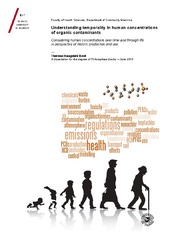| dc.contributor.advisor | Odland, Jon Øyvind | |
| dc.contributor.author | Nøst, Therese Haugdahl | |
| dc.date.accessioned | 2015-11-04T12:26:17Z | |
| dc.date.available | 2015-11-04T12:26:17Z | |
| dc.date.issued | 2014-06-25 | |
| dc.description.abstract | Modern human lifestyle depends on a great number of synthetic chemicals and many designated as persistent organic pollutants (POPs). There are concerns for harmful health effects of POPs even for the background exposure experienced by the general population and especially for foetuses and children.
The overarching aim of this thesis was to enhance our understanding of how human concentrations of POPs have changed in individuals over time. Five repeated measurements from 54 men in the Tromsø Study, Northern Norway provided longitudinal serum data from 1979 to 2007 for polychlorinated biphenyls (PCBs), organochlorine pesticides and per- and polyfluoroalkyl substances (PFASs). Concentrations of most PCBs and pesticides decreased from 1979 or 1986 and likely reflect the decreasing concentrations in the environment during the same period. Concentrations increased for some PFASs from 1979 until 2001 when major productions were phased out and decreased to 2007. For other PFASs, concentrations increased during the entire study period. Many of the compounds measured were banned before or during the study period and the time trends of POP concentrations display a strong link to production and use of these compounds. These time trends clearly show that initiatives to stop production and use of POPs have led to decreasing concentrations of the same POPs in humans.
Measured concentrations of PCBs were compared with concentrations predicted by emission-based mechanistic exposure modelling. The model simulations for PCB concentrations demonstrated reliable performance to reproduce median measured concentrations of PCBs in the Northern Norwegian men. Person-specific predictions were obtained for pregnant and postmenopausal women and they were in agreement with measurements. Predicted concentrations from birth until blood sampling for the study subjects demonstrated large differences between individuals in peak concentrations and temporal changes. Also, these results demonstrate the potential of mechanistic models as useful tools in human biomonitoring and effect studies. | en_US |
| dc.description.doctoraltype | ph.d. | en_US |
| dc.description.popularabstract | Hensikten med arbeidet var å øke forståelsen av menneskers konsentrasjoner av miljøgifter over tid. En gruppe menn hadde gitt fem blodprøver til Tromsøundersøkelsen mellom 1979 og 2007 og ved hjelp av disse prøvene kunne tidstrender av 51 miljøgifter bestemmes. Miljøgifter som ble forbudt før 1979, for eksempel DDT, sank fra den første prøven. For stoffer der forbud eller bruksstopp startet i løpet av perioden, som for PCBer eller PFOS, begynte konsentrasjonene å synke ikke lenge etter. Funnene viser at menneskenes konsentrasjoner av en miljøgift endres i takt med bruken av den og konsentrasjonene i våre omgivelser.
Konsentrasjoner av PCBer i mennene fra Tromsø ble sammenlignet med predikerte konsentrasjoner fra modellsimuleringer og overensstemmelsen var god. PCB prediksjoner for hver enkelt person i to grupper norske kvinner stemte også godt overens med målte konsentrasjoner. Dette styrker tiltroen til slike modeller som kan brukes til å estimere PCB konsentrasjoner gjennom hele livet. | en_US |
| dc.description.sponsorship | The project was financially supported by the Northern Norway Regional Health Authority, the Fram Centre and the EU project ArcRisk (www.arcrisk.eu). | en_US |
| dc.description | Paper II of this thesis is not available in Munin.<br>Repeated measurements of per‐ and polyfluoroalkyl substances (PFASs) from 1979 to 2007 in males from Northern Norway: Assessing time trends, compound correlations and relations to age/birth cohort. Nøst, TH, Vestergren, R, Berg, V, Nieboer, E, Odland, JØ, Sandanger, TM.<br>Available in <a href=http://dx.doi.org/10.1016/j.envint.2014.02.011> Environment International, 2014, vol. 67</a> | en_US |
| dc.identifier.uri | https://hdl.handle.net/10037/8257 | |
| dc.identifier.urn | URN:NBN:no-uit_munin_7838 | |
| dc.language.iso | eng | en_US |
| dc.publisher | UiT The Arctic University of Norway | en_US |
| dc.publisher | UiT Norges arktiske universitet | en_US |
| dc.relation.ispartofseries | ISM skriftserie; 151 | |
| dc.rights.accessRights | openAccess | |
| dc.rights.holder | Copyright 2014 The Author(s) | |
| dc.rights.uri | https://creativecommons.org/licenses/by-nc-sa/3.0 | en_US |
| dc.rights | Attribution-NonCommercial-ShareAlike 3.0 Unported (CC BY-NC-SA 3.0) | en_US |
| dc.subject | VDP::Medical disciplines: 700::Health sciences: 800::Other health science disciplines: 829 | en_US |
| dc.subject | VDP::Medisinske Fag: 700::Helsefag: 800::Andre helsefag: 829 | en_US |
| dc.subject | The Tromsø Study | |
| dc.subject | Tromsøundersøkelsen | |
| dc.title | Understanding temporality in human concentrations of organic contaminants
-Considering human concentrations over time and through life in perspective of historic production and use | en_US |
| dc.type | Doctoral thesis | en_US |
| dc.type | Doktorgradsavhandling | en_US |


 English
English norsk
norsk


